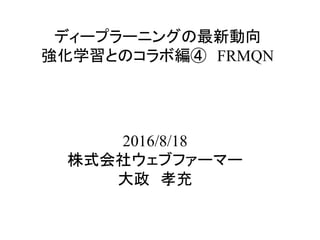
The introduction to FRMQN model
- 2. 今回取り上げるのはこれ [1]J. Oh, V. Chockalingam, S. Singh, H. Lee. “Control of Memory, Active Perception, and Action in Minecraft” arXiv: 1605.09128, 2016. DQNに記憶装置をとりつけることで、Minecraftでの得点で 従来手法を上回った!
- 3. 通常のDQN部分は・・・ 通常のDQN部分の全体像は塚原裕史氏「論文紹介 Playing Atari with Deep Reinforcement Learning」[2] http://www.slideshare.net/htsukahara/paper-intoduction-playing-atari- with-deep-reinforcement-learning や藤田康博氏「Playing Atari with Deep Reinforcement Learning」[3] http://www.slideshare.net/mooopan/ss-30336609 もしくは私の「ディープラーニングの最新動向 強化学習とのコラボ編① DQN」[4] http://www.slideshare.net/ssuser07aa33/introduction-to-deep-q-learning などを参照してください
- 9. 書き込み① 入力画像をCNNでencoding [1]Figure 2 h c w 入力画像 xt CNNでencoding → et =ϕ xt( ) e et xt ∈ Rc×h×w et ∈ Re
- 10. 書き込み② 過去 期間の から とする [1]Figure 2 過去 期間の → Et = et−1,et−2,!,et−M[ ] e Et Et ∈ Re×M etM Et etM M
- 11. 書き込み③ をkeyに変える重み [1]Figure 2 encode をkeyに変える重み W key e Et W key ∈ Rm×e W key m W key Et
- 12. 書き込み④ 記憶のkeyとなる を作成 [1]Figure 2 と との積から記憶のkeyとなる を作成 M Et Mt key ∈ Rm×M Mt key m Mt key = W key Et Mt key W key
- 13. 書き込み⑤ の中身 [1]Figure 2 M 2 5 3 ! 4 1 2 1 ! 2 2 6 2 ! 3 4 0 2 ! 1 ⎡ ⎣ ⎢ ⎢ ⎢ ⎢ ⎤ ⎦ ⎥ ⎥ ⎥ ⎥ m Mt key に対するkeyt − 2 は例えばこんな感じ Mt key
- 14. 書き込み⑥ を記憶に変える重み [1]Figure 2 encode を記憶に変える重み W val e Et W val ∈ Rm×e W val m W val Et
- 15. 書き込み⑦ 記憶 を作成 [1]Figure 2 と との積から記憶 を作成 M Et Mt val ∈ Rm×M Mt val m Mt val = W val Et Mt val W val
- 16. 書き込み⑧ の中身 [1]Figure 2 M 3 4 1 ! 8 7 0 1 ! 2 2 6 4 ! 1 1 2 2 ! 0 ⎡ ⎣ ⎢ ⎢ ⎢ ⎢ ⎤ ⎦ ⎥ ⎥ ⎥ ⎥ m Mt val に対する記憶t − 2 は例えばこんな感じ Mt val
- 17. 読み込み① contextを入力 context m ht ht ∈ Rm 3 2 7 1 ! 4 ⎡ ⎣ ⎢ ⎢ ⎢ ⎢ ⎢ ⎢ ⎢ ⎤ ⎦ ⎥ ⎥ ⎥ ⎥ ⎥ ⎥ ⎥ m に関する部分t − 2 [1]Figure 2
- 18. 読み込み② 各 に対する注目重みを計算 と とのsoftmaxで 注目重み を計算する m ht pt,i ∈ R t Mt key i[ ] pt,i pt,i = exp ht Τ Mt key i[ ]⎡⎣ ⎤⎦ exp ht Τ Mt key j[ ]⎡⎣ ⎤⎦j=1 M ∑ [1]Figure 2
- 19. 読み込み③ を直感的に理解する 現在のcontextに反応した 過去の記憶のある時刻部分 が として着火するイメージ ht Τ pt,i m m⊗ [1]Figure 2 Mt key i[ ] t = 2 pt,i
- 20. 読み込み④ が集まって注目重み pt [1]Figure 2 pt = pt,1, pt,2,!, pt,M ⎡⎣ ⎤⎦ pt,i 全部集めて注目重み とするpt pt ∈ RM
- 21. 読み込み⑤ 記憶を引き出す [1]Figure 2 ot = Mt val pt 注目重み を手掛かりに 記憶 を引き出す pt pt ∈ Rm Mt val
- 22. 読み込み⑥ 記憶を引き出すイメージ [1]Figure 2 大きな注目重み に対応 する の 番目が 反応する pt Mt val i[ ] pt m ⊗ Mt val M i M このへんの 値が大きいこのへんが 主に引き出 される
- 23. 最後に出力 [1]Figure 2 qt =ϕq ht,ot( ) cntext と記憶装置からの出 力 を全結合層に入力し、 全体の出力 を出す ht qt ot ht qt qt ∈ Ra gt = f W h ht +ot( ) qt = W q gt
- 27. MQNでのcontext [1]Figure 2 ht CNNの出力 に重み をかけてcontext とする ht = W c et W cet et ht htW c W c ∈ Rm×e
- 29. RMQNでのcontext [1]Figure 2 ht CNNの出力 とメモリセル の出力 、recurrentの をLSTMに入力する ht,ct[ ]= LSTM et,ht−1,ct−1( ) et et ht−1 ht RはrecurrentのR →LSTMを使う LSTMht−1,ct−1 ct−1 :メモリセルの出力 →peephole ct−1 ct−1 ∈ Rm
- 31. FRMQNでのcontext LSTMの入力に記憶装置から の出力 を加える ht,ct[ ]= LSTM et,ot−1[ ],ht−1,ct−1( ) et ot−1 ht LSTMの入力に を加える LSTMht−1,ct−1 ot−1 ot ot−1 [1]Figure 2
- 38. I 字型迷路の結果① l 新手法はDQNやDRQNより早く収 束している。特にFRMQNが早い。 l DRQNは早く下方に到達するよう になった後、左右いずれを選択す るかを学習するのに時間がかかる。 l 一方、新手法は左右の選択を早く 学習できる [1]Figure 3,6 indicatorの情報を思い出すのは下方 到達時だけでいい。DRQNは長い廊 下を下る間、indicatorの情報を保持す るのが難しい。一方で新手法は下方 に到達したというcontextによって indicatorの記憶を引き出せるので、有 利。 得点の平均値 学習回数
- 42. パターンマッチングの結果 l 新手法はDQNやDRQNより高い 値に収束した l DRQNは下方のゴールいずれか には達するようになるが、正しい 方を選択する事を学習できない [1]Figure 3,6 l DRQNは異なる時間で観察した画 像をマッチングさせるのが難しい? l FRMQNはいずれの記憶もcontext にそって呼び起こし、マッチングさ せされるのでいい結果につながっ ているか? 得点の平均値 学習回数
- 45. ランダムな迷路の結果① training data training dataでの収束状況 [1]Figure 3,6 得点の平均値 学習回数 FRMQNやRMQNが得点が高いが、 DRQNもそこそこ高い
- 46. ランダムな迷路の結果② unseen map training dataにはないテスト用 の迷路で汎化性能を確認 [1]Figure 3,6 得点の平均値 学習回数 汎化性能はFRMQNやRMQNが高い
- 48. 終わり